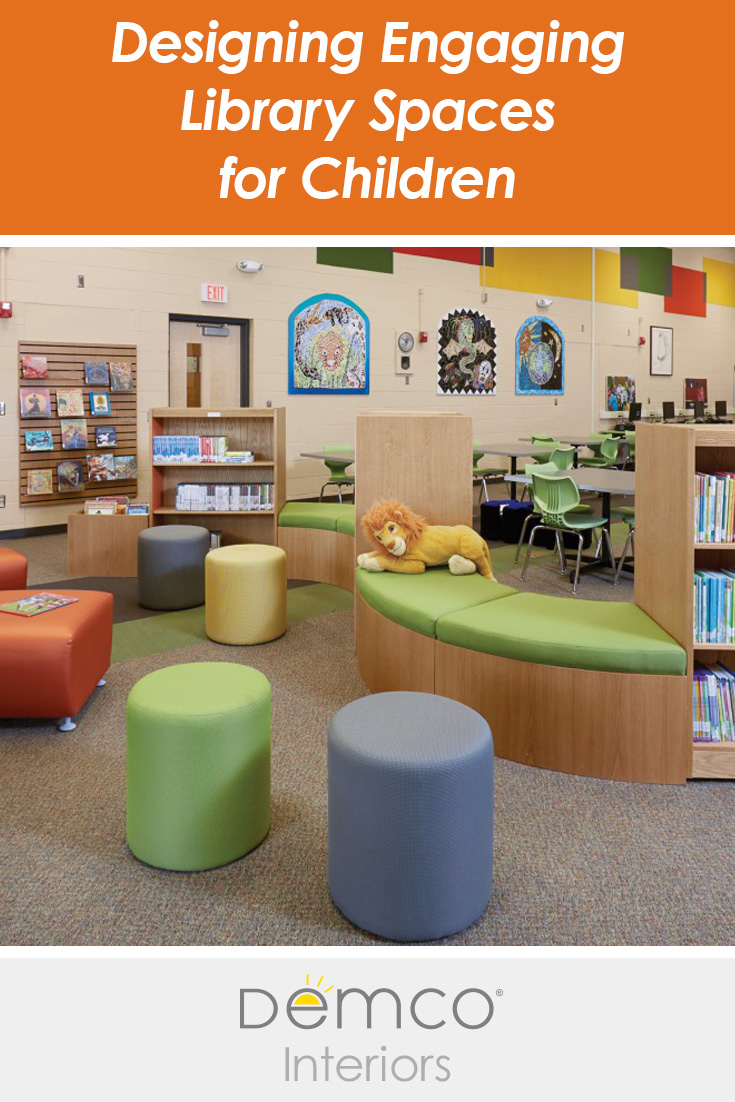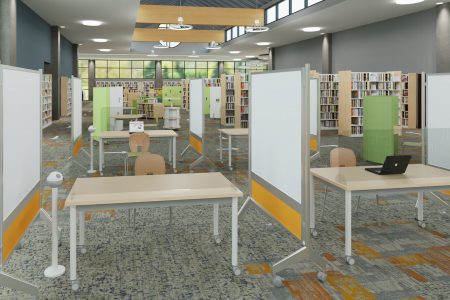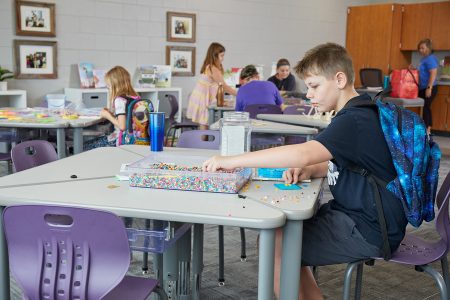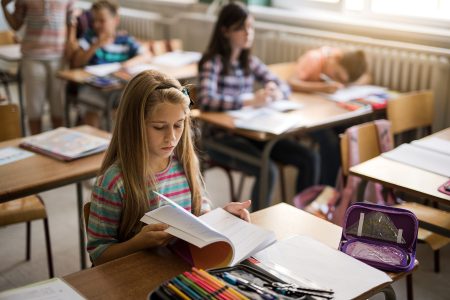The early school years are filled with new adventures. Many 5-year-olds are transitioning from days of play to school routines. Seven- to 8-year-olds are becoming more independent and developing personal interests. Overall, school-aged children are learning to be social and to understand the differences between right and wrong and winning and losing. This age group is also learning to read, write and become problem solvers. And, as anyone who’s spent time in an elementary classroom knows, kids this age are filled with unlimited energy.
Successful library service to young school-aged children means creating library spaces and programs that address their needs and engage their developing and curious minds. Use the following checklist as a guide for evaluating your space so you can ensure your library is a place where kids are safe, secure and open to learning.
Demco interior designers created zoned areas that offer a variety of seating and spaces for all students at Abraham Lincoln Elementary School.
Space
An inviting, friendly and comfortable atmosphere keeps kids coming back.
- Having different inviting areas, or zones, in your children’s space will attract a variety of ages and interests. Although the size of your library will dictate the amount of space you can dedicate to each of these areas, try to accommodate the widest variety of needs.
- Provide easy access to general collections for this age group, including easy readers, upper-level fiction and nonfiction.
- Develop a quiet space for studying and recreational reading, as well as social space for chatting and general interaction.
- Provide general collaboration space for group work, teaching opportunities, small-group programming and instruction.
- Integrate interactive areas throughout for active gaming, problem-solving activities, art and literature sharing.
- Develop a creation space or makerspace, where kids can tinker and invent.
- Establish a large-group programming and event space that can serve a variety of purposes and adapt as needed.
In the Kenosha Public Library, light, color, open space and playful furnishings draw kids into the space.
Decor
The decor of your space will set the tone and tell young readers it’s not just a space for preschoolers.
- Choose a general color scheme that is attractive and inviting. Create some energy and interest by adding pops of color in strategic places.
- Use carpet tiles or area rugs to help define the space and add color and interest.
- Review wall and vertical spaces for places to hang kids’ artwork and other visually appealing items.
- Make signage easy to read and follow. Good signage not only enhances the look of library spaces, but it’s also a great way to help kids build confidence.
Demco interior designers added pops of color seating to encourage kids to hang out at Washington Elementary School.
Furnishings and Fixtures
Appropriate furnishings help define and enhance the look of library spaces, but they also contribute to learning and positive interactions. For public libraries with limited space, as well as school media centers that are often the hub for hosting events, flexibility is a must.
- Make it easy to adapt your overall space by incorporating mobile tables, shelving and stackable chairs, which will allow you to transform your space for multiple uses.
- Incorporate a variety of comfortable seating in both quiet spaces and social areas.
- Balance formal spaces for collaboration and learning with casual spaces for socializing and developing friendships.
- Include ergonomic seating and tables for computing and technology areas.
- Include chairs with 14″H seats paired with 22–25″H tabletops.
- Organize and label your materials in a way that helps kids make appropriate selections.
- Incorporate displays and storage systems that will enhance the visibility and accessibility of the collection.
- Make materials accessible by keeping shelving heights at 48″. Perimeter shelving can go up to 66″ if needed.
Demco helped Huegel Elementary renovate their library to include space for hands-on, collaborative learning.
Interactives
Learning and education come in many shapes and sizes. At this age, hands-on activity is a large part of healthy development. Incorporating interactives throughout your library spaces and collection serves to develop much-needed skills and connect kids to library materials.
- Include interactive elements throughout the area, such as magnetic poetry, whiteboard or LEGO® walls, art gallery space, board games, etc.
- Incorporate the elements listed above on often-empty end panels.
- Set up self-directed STEM stations with “I wonder …” statements to get kids thinking critically as they work with the materials.
- Include a creativity area where kids can invent, act out stories, sing, etc. This could be an open area that encourages general activity, a puppet theater or a place to work with manipulatives to build.
- Incorporate technology, such as iPads®, listening devices, interactive whiteboards, online resources, software and more.
- Provide access to digital creativity resources, including, but not limited to, audio and video production tools.
Approachable and Welcoming Service
Positive communication from all staff will encourage the nurturing of relationships that help children learn and grow.
- Create a centrally located, friendly service point.
- Include a self-check station for kids to check out their own materials.
- Engage in good merchandising techniques, whether by creating a popular children’s library near the main service point, incorporating child-friendly signage and/or incorporating face-out merchandising throughout the area.
- Include digital signage to highlight programs and events for caregivers and older children that will bring them back for new library experiences.
- Provide a safe atmosphere with nearby amenities such as seating, laptop access, power access, etc., so adults and caregivers can easily keep an eye on their children as they engage with your public library spaces.
Stephen Gower
Stephen leads Demco’s Design Services team. He is an experienced furniture, product and interior designer with a background in designing educational products and impactful educational interiors. Stephen has 20 years of design experience, including 5 years of international experience at Demco Interiors UK in England.
Stephen holds a Bachelor of Arts, with honors, in Furniture Design from Brunel University in High Wycombe, England. His awards include the 2017 EDspaces Classroom Design Winner, awarded for “unique spaces designed by leading architects and designers in the field and outfitted with the latest innovations that make learning spaces come to life.”
Latest posts by Stephen Gower (see all)
- Library Design Tips for Social Distancing - May 28, 2020
- How Biophilic Learning Environments Boost Student Achievement - October 14, 2019
- Checklist: Designing Engaging Library Spaces for Children - October 19, 2018
- Top 5 Learning Environment Design Trends - September 21, 2018
- 5 Tips for Planning Early Literacy Library Spaces - August 1, 2018
Angela Loewecke
Latest posts by Angela Loewecke (see all)
- Checklist: Designing Engaging Library Spaces for Children - October 19, 2018
- Top 5 Learning Environment Design Trends - September 21, 2018
- 5 Tips for Planning Early Literacy Library Spaces - August 1, 2018
- Library Furniture That Wowed Us - July 14, 2018
Amber Benesch
Latest posts by Amber Benesch (see all)
- Checklist: Designing Engaging Library Spaces for Children - October 19, 2018
- Top 5 Learning Environment Design Trends - September 21, 2018
- 5 Tips for Planning Early Literacy Library Spaces - August 1, 2018
- Library Furniture That Wowed Us - July 14, 2018
- Top 5 Things to Consider When Choosing Furniture for Your Library - April 20, 2018







